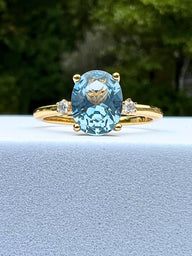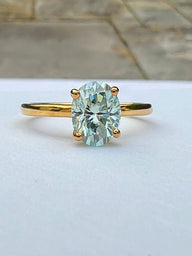FREE SHIPPING | BUY NOW, PAY LATER
Jewelers use a lot of different terms when it comes to gold. Some unscrupulous jewelers may purposely try to mislead you, while others forget that non-jewelers aren't knowledgeable about the differences in gold. To help you be a more informed buyer, we think you should look out for these terms below to avoid overpaying for items from dishonest sellers, or to be assured that you're getting good quality for the price you're paying.
Gold Finish
Shockingly, searching through many brand name designer websites, these companies will list their jewelry as "gold finish", while charging you hundreds or even thousands of dollars! Gold finish is NOT real gold but instead painted a gold color. The benefit for these companies is that there's no gold plating that will wear off, so most customers won't complain after their $1,000 ring starts to wear down in a month. We urge you to look at the description on designer websites, or Etsy, to see exactly the gold material the seller is using, and if you're not sure, to either Google it or ask them.
P.S. "gold color" is another term for painted gold (not real gold), though, this term seems less dishonest.
Gold Plated
Gold plated jewelry in the U.S. legally has to be 0.5 microns of gold, with a micron being one-thousandth of a millimeter. In reality, no one is actually checking and many companies either don't know or use a lot less gold, like 0.01 microns of gold. A way to check is to ask the vendor, and if they don't know, that's usually not the best sign, as their manufacturer may be giving them a very little amount of gold plating. Either way, gold plating will wear quickly, which is why it shouldn't be expensive (unless you're a well-known designer brand). You should also look at the underlying metal because once the plating wears, your skin will be exposed to it. Many companies will use materials like brass or copper because they're cheap, but we choose to use sterling silver because it's hypoallergenic and better quality material.
Gold Vermeil
In the U.S., gold vermeil is sterling silver with 2.5 microns of plating. In other countries, like Canada, it's 1 micron of gold plating. Since we're a U.S. company, we go by U.S. standards, so all of our jewelry listed as gold vermeil is at least 2.5 microns. Also, for gold vermeil, the gold has to be at least 10k, though most gold vermeil jewelry we've seen is 14k or 18k. There shouldn't be much of a price difference in the karats for gold vermeil or gold plated jewelry, but it's more just a preference in aesthetics, with 18k yellow gold being a lighter shade than 14k gold.
Even though gold vermeil jewelry has at least 5x more gold than gold plating, unfortunately, the gold will wear too, which is why it's important to take good care of it. Again, there's no one really testing to make sure that gold vermeil is 2.5 microns of gold, and many sellers know this, which is why unknowing or unscrupulous sellers will list their jewelry as gold vermeil, as long as sterling silver is underneath a layer on gold. Besides taking your jewelry to a lab to test it (which would be expensive!), we would recommend asking the seller how many microns of gold the jewelry piece has or looking through comments about how long the piece has lasted other people before the gold started rubbing off. It's hard to say how long gold vermeil will last because the most important factor is how well you take care of your jewelry, but we'd say it should last at least a few months before the plating starts wearing out, assuming that you aren't doing anything too crazy with your jewelry.
Gold Filled
Gold filled is gold that is bonded to a base metal, like copper, brass, or sterling silver. In the U.S., the gold in gold filled jewelry has to be at least 5% of the jewelry pieces' total weight. Even though gold filled jewelry usually has a cheaper base metal than gold vermeil, the benefit is that the gold will last longer than gold vermeil or gold plated jewelry due to having more gold and also the bonding process.
Though not as expensive as solid gold, gold filled is generally more expensive than gold vermeil, because it will last longer, and it's also a more expensive and time-consuming to make. It still will tarnish though! If you have a nickel allergy or are sensitive to certain metals, we recommend looking into what the underlying metal is!
Solid Gold
Solid gold is, well...solid gold. There's no base metal. It comes in different karats, with the more karats having more gold content, meaning it will be a higher price. At this moment we don't offer solid gold products, but please either reach out or respond in the comments if that's something you're interested in.
10k Gold
10k gold is the least pure, least expensive, but most durable type of gold, with 41.7% gold and 58.3% alloy metals, like zinc, nickel, and silver.
Pros:
It's the hardest to scratch, as gold scratches quite easily. It's also the cheapest.
Cons:
If you have a nickel allergy, you should be careful about wearing 10k gold.
14k Gold
14k gold is 58.3% gold and 41.7% alloy metal, and very popular in the U.S.
Pros:
It has a nice balance between durability, price, and brightness.
Cons:
If you have a nickel allergy, you still may have a reaction to 14k gold.
18k Gold
18k gold is 75% gold and 25% alloy metals.
Pros:
If you have a nickel allergy, you'll be fine! There's a good chunk of gold in there to negate any effects of nickel. Also, in our opinion, 18k gold looks the best with its' bright yellow hues, but as they say, beauty is in the eye of the beholder.
Cons:
It's less durable than 10k and 14k gold, so you should be extra careful not to scratch it.
24k Gold
This is 100% gold, the holy grail. No ifs' ands, or buts!
Pros:
It's pretty rare! Also, since it's pure gold, some people think of it as an investment, though we doing so. If you want to buy gold for investment purposes, there are better ways of doing so than buying jewelry.
Lastly, if you want a rare, expensive, and unique jewelry piece as a family heirloom, or even as a gift to yourself, 24k gold is great for that.
Cons:
Not only does it easily scratch, but it's soft, so it can bend. So word of caution, please take it off before doing any martial arts, pickleball, or even thumb wrestling.
We hope you're now a little bit more knowledgeable about gold. We'd love to hear any comments, questions, or concerns you may have, so please either get in touch or write in the comments :).







